Did you know that nearly 10% of motorcycles experience fuel leaks at some point in their lifespan? These leaks can stem from a variety of issues, ranging from worn-out fuel lines to faulty carburetors. Understanding the root causes is essential for any rider who wants to maintain their bike's performance and safety. What factors contribute to these leaks, and how can you identify them before they become serious problems?
Key Takeaways
- Fuel line issues, such as cracks or loose connections, can lead to dangerous fuel leaks in motorcycles.
- Malfunctioning carburetors, like stuck floats, may cause fuel overflow and leaks.
- Damaged fuel tanks from dents or rust can compromise integrity and result in leaks.
- Aging gaskets and seals may become brittle, causing fuel to escape from connections.
Overview of Ducati Motorcycles
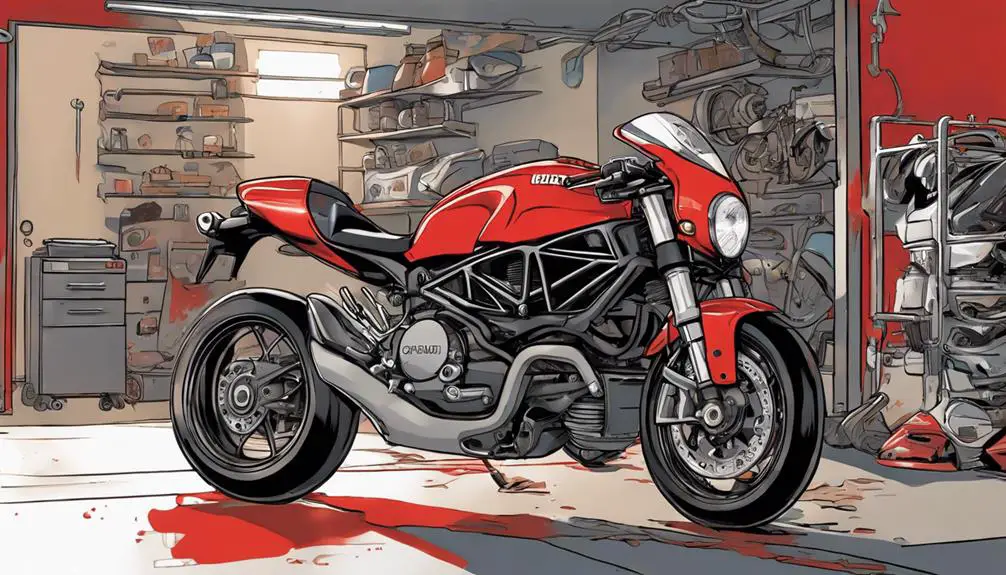
Ducati motorcycles stand out for their blend of Italian craftsmanship and cutting-edge performance, making them a favorite among enthusiasts. When you ride a Ducati, you're not just on a bike; you're experiencing a lifestyle steeped in passion and precision. Each model reflects the brand's commitment to innovation and freedom on the open road.
You'll find that Ducati's design philosophy marries stunning aesthetics with functional engineering. The lightweight frames and powerful engines create an exhilarating ride that connects you with the machine. Whether you're carving through winding roads or cruising down the highway, the thrill you feel is palpable. The sound of a Ducati's engine is music to your ears, inviting you to push the limits and embrace the adventure.
Ducati also fosters a sense of community among riders. You're part of a tribe that shares your love for speed and sophistication. The brand's racing heritage adds to this allure, inspiring you to take on challenges and seek new horizons. Owning a Ducati isn't just about having a motorcycle; it's about liberating your spirit and indulging your need for excitement and freedom.
Common Fuel Leak Symptoms
When you notice a strong gasoline odor or see fuel pooling underneath your motorcycle, it's crucial to investigate these common fuel leak symptoms. Ignoring them can lead to more serious issues and compromise your ride's safety.
One of the first signs you might notice is wet spots or streaks on your bike, especially around the fuel tank or connections. This indicates that fuel is escaping, and it can happen even if you don't smell gasoline immediately.
Another symptom to watch for is inconsistent engine performance. If your motorcycle starts sputtering, struggling to maintain speed, or stalling unexpectedly, it could be a result of fuel leaking. Additionally, frequent refueling might indicate a hidden leak, as you're burning through more gas than usual.
You should also keep an eye on your fuel gauge. If it's dropping faster than normal without any explanation, it's time to take action. Trust your instincts; if something feels off, don't hesitate to investigate further.
Addressing these symptoms promptly not only enhances your riding experience but also guarantees your freedom on the open road remains unhampered.
Fuel Line Issues
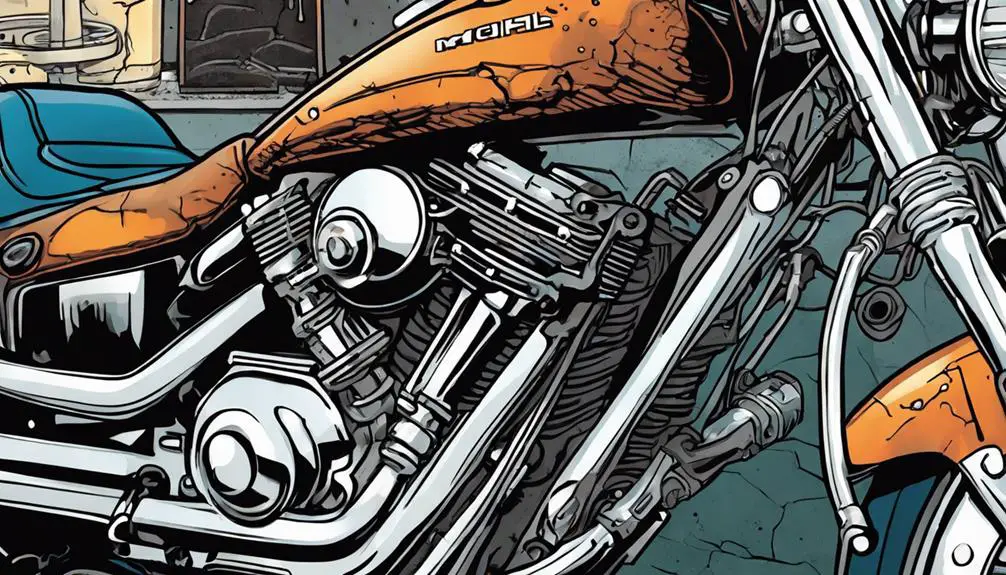
Inspecting your fuel lines regularly can help you catch issues before they lead to dangerous leaks. These lines transport fuel from the tank to the engine, and any wear or damage can cause significant problems. Look for cracks, fraying, or kinks in the lines. Even minor abrasions can lead to leaks, especially under pressure.
Don't forget to check the connections where the fuel lines meet the tank and the engine. Loose fittings can create gaps, allowing fuel to escape. Tighten any loose connections, but be careful not to over-tighten them, as that can cause further damage.
Temperature changes and exposure to elements can also affect your fuel lines. If you ride in extreme weather, it's essential to inspect them more often. Use high-quality replacement parts if you need to replace any lines, as subpar materials can lead to more problems down the road.
Your motorcycle is more than just a machine; it's a vessel for freedom. Keeping your fuel lines in top shape guarantees you can enjoy the open road without worrying about unexpected leaks. Regular maintenance empowers you to ride with confidence.
Carburetor Problems
Carburetor problems often lead to fuel leaks that can disrupt your ride and compromise safety. When your carburetor isn't functioning properly, it can cause excess fuel to overflow, creating a dangerous situation. You might notice fuel pooling underneath your bike or smell gas, and that's a clear sign that something's off.
A common culprit is a stuck float, which can prevent the carburetor from shutting off, allowing fuel to spill out. If the float's needle valve is worn or damaged, it won't seal correctly, leading to leaks. Additionally, clogged jets can cause your engine to run lean, which can overcompensate by pushing more fuel into the carburetor than needed.
Regularly checking your carburetor's condition can free you from these issues. Cleaning it and replacing worn parts can prevent leaks and keep your machine running smoothly.
You deserve a ride that feels exhilarating, not one that's hampered by mechanical failures. So, take charge of your bike's maintenance, and liberate yourself from the constraints of carburetor problems that can lead to frustrating fuel leaks. Embrace the open road, knowing your ride is in top shape!
Fuel Tank Integrity
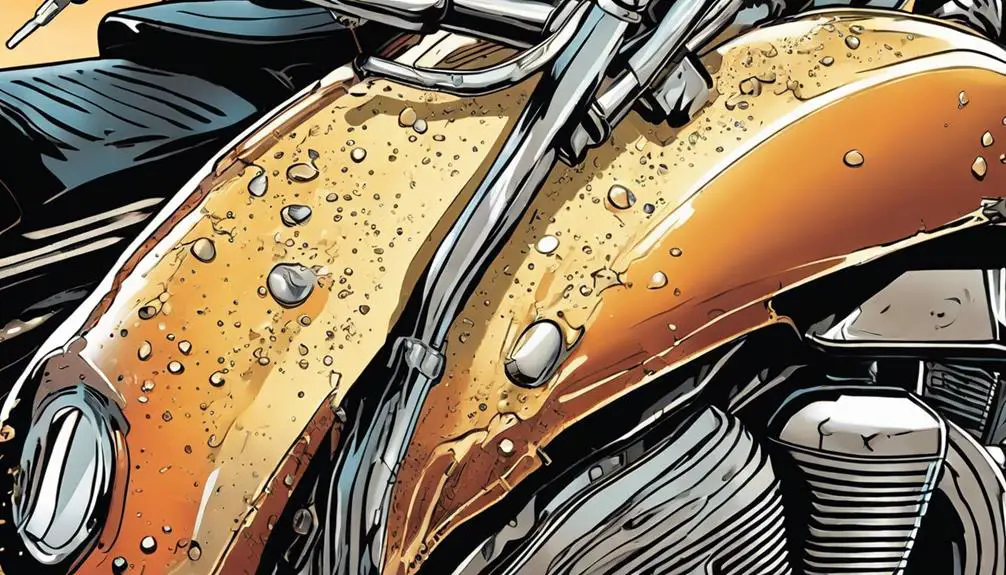
Maintaining the integrity of your fuel tank is essential for preventing leaks that can jeopardize both your ride and your safety. A sturdy, well-maintained fuel tank keeps your fuel where it belongs—inside.
Regularly inspect your tank for dents, rust, or any signs of wear. If you notice any defects, don't ignore them; they could lead to catastrophic leaks down the road.
When you fill your tank, be mindful of overfilling. Fuel expands, and if you pack it too tightly, it can escape through the tank's venting system. Confirm the cap is secure and free from cracks, as a damaged cap can allow fuel to evaporate and cause leaks.
Temperature fluctuations can also affect your tank's integrity. Sudden changes can create stress on the material, leading to cracks. So, if you ride in extreme conditions, be vigilant.
Don't forget to evaluate the mounting points and connections. Loose fittings can lead to vibrations that weaken the fuel tank over time.
Gasket and Seal Failures
Gasket and seal failures are common culprits behind fuel leaks in motorcycles.
You might notice that aging gasket materials can become brittle, leading to cracks and leaks.
Additionally, improper installation techniques can compromise the seal's integrity, making it essential to pay attention to both factors.
Aging Gasket Materials
Over time, the materials used in gaskets and seals can degrade, leading to fuel leaks in your motorcycle. This degradation often results from exposure to heat, oil, and other harsh conditions you're likely to encounter on the road. As these materials age, they lose their flexibility and integrity, creating gaps where fuel can escape.
When you're out riding, you want to feel the thrill of freedom without worrying about your bike's performance. A compromised gasket can ruin that experience, causing not only fuel leaks but also potential engine damage if left unchecked. Regularly inspecting your motorcycle's gaskets and seals is crucial to maintaining that sense of liberation.
If you notice any signs of wear or deterioration—like swelling, cracking, or discoloration—don't hesitate to take action. Replacing aging gaskets is a proactive step that guarantees your ride remains smooth and leak-free.
Trust in the power of preventive maintenance to keep your motorcycle in peak condition, allowing you to fully embrace the open road ahead. Stay vigilant, and your motorcycle will reward you with countless adventures.
Improper Installation Techniques
Improper installation techniques can lead to gasket and seal failures, resulting in frustrating fuel leaks that compromise your motorcycle's performance. When you rush through a job or overlook vital details, you risk creating gaps or misalignments. This negligence can cause your gaskets to fail prematurely, allowing fuel to escape where it shouldn't.
Always verify that surfaces are clean and free of debris before installing gaskets or seals. If you don't, you're setting yourself up for disaster. Use the right torque specifications too; over-tightening can crush gaskets, while under-tightening can lead to leaks.
You've got the power to liberate your ride from these issues by taking your time and doing it right the first time.
Also, consider the type of gasket material you're using. Not all gaskets are created equal; some may not withstand the pressures of your specific motorcycle. Trust your instincts and knowledge, and don't hesitate to seek guidance if you're unsure.
Fuel Filter Blockages
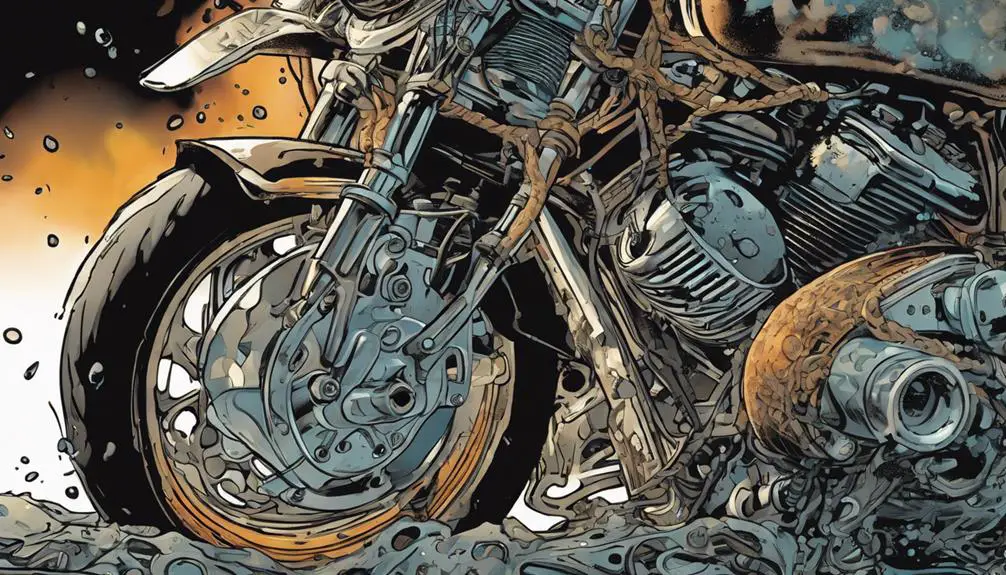
Fuel filter blockages can lead to reduced performance and increased risk of fuel leaks in your motorcycle. When dirt, debris, or contaminants accumulate in your fuel filter, it restricts the flow of fuel to the engine. This restriction not only hampers your bike's efficiency but can also create pressure buildup, which may ultimately cause leaks in the fuel system.
You might notice symptoms like sluggish acceleration, stalling, or difficulty starting your motorcycle. These issues can feel frustrating, especially when you crave the freedom of the open road. Regularly inspecting and replacing your fuel filter is crucial to maintain peak performance and safeguard against leaks.
To liberate yourself from potential complications, consider incorporating fuel filter checks into your maintenance routine. This simple step guarantees you're not just cruising smoothly but also protecting your bike from unnecessary wear and tear.
Fuel Pump Malfunctions
When it comes to fuel pump malfunctions, you need to contemplate both electrical issues and mechanical wear and tear.
These problems can lead to leaks that not only affect your bike's performance but could also pose safety risks.
Electrical Issues
Electrical issues, particularly fuel pump malfunctions, can lead to dangerous fuel leaks in your motorcycle if not addressed promptly. When the fuel pump isn't functioning correctly, it may not deliver the right amount of fuel to the engine, causing excess pressure that can damage fuel lines or connections. You might notice irregular engine performance or strange sounds coming from the pump, signaling that something's off.
Ignoring these signs could mean risking not just a leak but also your safety on the road. A malfunctioning fuel pump can create an environment ripe for leaks, potentially spilling fuel onto hot engine parts. This isn't just an inconvenience; it's a serious fire hazard.
You've got the power to take control of your ride. Regularly inspect your electrical system, and don't hesitate to troubleshoot or seek professional help when you suspect issues. Keeping your fuel pump in good shape isn't just about maintaining performance; it's about ensuring your freedom and safety as you ride.
Don't let electrical issues limit your journey—stay vigilant, stay informed, and keep your motorcycle in top condition for the open road ahead.
Mechanical Wear and Tear
Dealing with mechanical wear and tear in your motorcycle can lead to fuel pump malfunctions that create serious leak risks. As you ride, components like the fuel pump endure constant stress, which can lead to deterioration over time. If you ignore this wear, you might face the frustrating consequences of fuel leaks that not only compromise your ride but also your safety.
When the fuel pump's internal parts start to fail, they can cause weak seals or cracks. This damage allows fuel to escape, creating hazardous situations. You might notice symptoms like a strong fuel smell or drops pooling under your bike. If you experience these signs, it's time to take action.
Regular maintenance is essential for keeping your motorcycle in top shape. Checking your fuel system, including the pump, can help you spot issues early and prevent leaks.
Don't wait until it's too late; embrace the freedom of the open road by ensuring your bike runs smoothly. By staying proactive, you're not just protecting your ride — you're also liberating yourself from the headaches of unexpected repairs and potential accidents.
Preventative Maintenance Tips
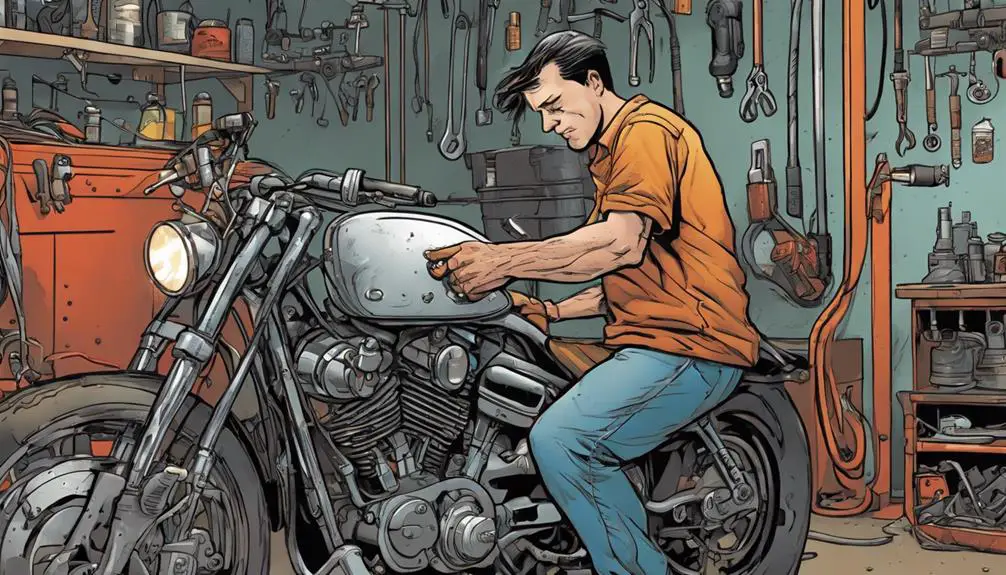
Regularly inspecting your motorcycle's fuel system can greatly reduce the risk of leaks and enhance overall performance. Start by checking the fuel lines for cracks or signs of wear. Rubber hoses can deteriorate over time, so replace them if you notice any damage. Don't forget to examine the connections and clamps, ensuring they're tight and free from corrosion.
Next, inspect the fuel tank for rust or dents that might compromise its integrity. A clean tank promotes better fuel flow and reduces the risk of contamination. Also, pay attention to the fuel filter; replacing it as part of your routine maintenance can prevent debris from entering the system.
Consider using fuel stabilizers if you're storing your bike for an extended period. This helps prevent the buildup of varnish and keeps the fuel fresh. Finally, always use high-quality fuel to minimize the risk of impurities entering your system.
Frequently Asked Questions
How Can I Identify a Fuel Leak Early?
To identify a fuel leak early, you should regularly inspect your bike for any unusual odors or wet spots.
Check hoses and connections for cracks or wear.
If you notice any pooling liquid or a strong fuel smell, act quickly!
Keep an eye on your fuel gauge; sudden drops can signal a leak.
Trust your instincts, and don't hesitate to consult a mechanic if something feels off.
Your safety's worth it!
Are Fuel Leaks Dangerous for Motorcycle Safety?
Absolutely, fuel leaks can be dangerous for your motorcycle safety. They increase the risk of fire and can impair your bike's performance.
If you notice a leak, it's essential to address it immediately. Riding with a fuel leak not only puts you at risk but also endangers others on the road.
Stay vigilant, and make sure your bike is in top condition to enjoy the freedom of the ride without worry!
Can Weather Conditions Contribute to Fuel Leaks?
Absolutely, weather conditions can contribute to fuel leaks.
When temperatures fluctuate, materials can expand or contract, leading to cracks or weakened seals. Heavy rains can also wash away protective coatings, exposing vulnerable parts.
If you ride in extreme heat, fuel can vaporize, increasing pressure and causing leaks.
Keeping your motorcycle maintained and parked in a sheltered area helps you avoid these weather-related issues.
Stay vigilant and free from the worries of fuel leaks!
Is It Safe to Ride With a Minor Fuel Leak?
Riding with a minor fuel leak is like dancing on a tightrope; one wrong move could lead to disaster.
You might feel the thrill of freedom, but the risks outweigh the reward. Fuel can ignite, turning your liberation into a fiery nightmare.
How Often Should I Inspect My Motorcycle for Leaks?
You should inspect your motorcycle for leaks regularly, ideally every few rides or at least once a month.
Before hitting the road, take a moment to check for any signs of leakage, especially after long rides.
Staying vigilant not only guarantees your safety but also helps maintain your bike's performance.
Regular inspections empower you to catch potential issues early, giving you the freedom to ride with confidence and peace of mind.
Conclusion
To sum up, staying vigilant about your motorcycle's fuel system is essential to avoid costly leaks.
Like a watchful sentinel, you should regularly inspect fuel lines, carburetors, and gaskets, ensuring everything's in tip-top shape.
By addressing these potential issues early, you not only safeguard your ride but also enhance its longevity and performance.
So, gear up and make preventative maintenance part of your routine—your motorcycle will thank you for it on every thrilling ride ahead.